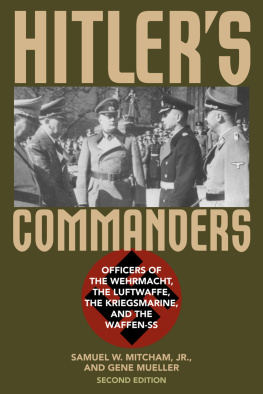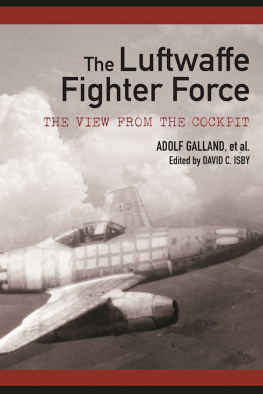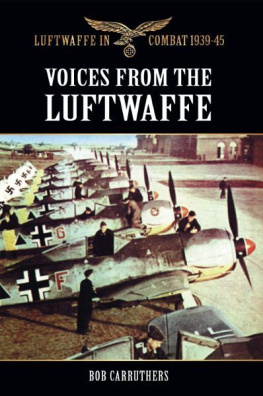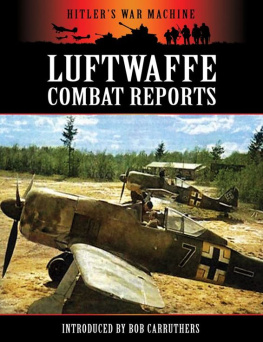EAGLES OF THE
THIRD REICH

Other titles in the Stackpole Military History Series

THE AMERICAN CIVIL WAR
Cavalry Raids of the Civil War
Picketts Charge
Witness to Gettysburg
WORLD WAR II
Armor Battles of the Waffen-SS, 194345
Army of the West
Australian Commandos
The B-24 in China
Backwater War
The Battle of Sicily
Beyond the Beachhead
The Brandenburger Commandos
The Brigade
Bringing the Thunder
Coast Watching in World War II
Colossal Cracks
D-Day to Berlin
Exit Rommel
Flying American Combat Aircraft of World War II
Fist from the Sky
Forging the Thunderbolt
Fortress France
The German Defeat in the East, 194445
German Order of Battle, Vols. 1, 2, and 3
Germanys Panzer Arm in World War II
Grenadiers
Infantry Aces
Iron Arm
Luftwaffe Aces
Messerschmitts over Sicily
Michael Wittmann, Vols. 1 and 2
The Nazi Rocketeers
On the Canal
Packs On!
Panzer Aces
Panzer Aces II
The Panzer Legions
Retreat to the Reich
Rommels Desert War
The Savage Sky
A Soldier in the Cockpit
Stalins Keys to Victory
Surviving Bataan and Beyond
Tigers in the Mud
The 12th SS, Vols. 1 and 2
THE COLD WAR / VIETNAM
Flying American Combat Aircraft: The Cold War
Land with No Sun
Street without Joy
WARS OF THE MIDDLE EAST
Never-Ending Conflict
GENERAL MILITARY HISTORY
Carriers in Combat
Desert Battles
EAGLES OF THE
THIRD REICH
Men of the Luftwaffe in World War II
Samuel W. Mitcham, Jr.
STACKPOLE
BOOKS
This book is dedicated to my lovely wife, Donna P. Mitcham

Copyright 1988 by Samuel W. Mitcham
Published in paperback in 2007 by
STACKPOLE BOOKS
5067 Ritter Road
Mechanicsburg, PA 17055
www.stackpolebooks.com
All rights reserved, including the right to reproduce this book or portions thereof in any form or by any means, electronic or mechanical, including photocopying, recording, or by any information storage and retrieval system, without permission in writing from the publisher. All inquiries should be addressed to Stackpole Books, 5067 Ritter Road, Mechanicsburg, PA 17055
Cover design by Tracy Patterson
Printed in the United States of America
10 9 8 7 6 5 4 3 2 1
Library of Congress Cataloging-in-Publication Data
Mitcham, Samuel W.
[Men of the Luftwaffe]
Eagles of the Third Reich: men of the Luftwaffe in World War II / Samuel W. Mitcham, Jr.
p. cm.(Stackpole military history series)
Originally published under the title: Men of the Luftwaffe. 1988.
Includes bibliographical references and index.
ISBN-13: 978-0-8117-3405-9
ISBN-10: 0-8117-3405-6
1. Germany. LuftwaffeHistoryWorld War, 19391945. 2. World War, 19391945Aerial operations, German. I. Title.
D787.M56 2007
940.54'4943dc22
2007003011
eISBN: 9780811744515
Table of Contents

| vi |
| vii |
|
| Chapter 1. | 1 |
| Chapter 2. | 14 |
| Chapter 3. | 31 |
| Chapter 4. | 51 |
| Chapter 5. | 80 |
| Chapter 6. | 95 |
| Chapter 7. | 114 |
| Chapter 8. | 127 |
| Chapter 9. | 149 |
| Chapter 10. | 173 |
| Chapter 11. | 200 |
| Chapter 12. | 207 |
| Chapter 13. | 236 |
| Chapter 14. | 266 |
|
| Appendix 1: | 279 |
| Appendix 2: | 281 |
| Appendix 3: | 282 |
| Appendix 4: | 283 |
| Appendix 5: | 286 |
| Appendix 6: | 293 |
|
| 301 |
| 325 |
| 335 |
Introduction

A re wars fought by men and machines, or are they fought by men with machines? Since history is truly argument without end, this question is somewhat moot, but for purposes of this book I adopt the second premise, since the machines themselves were (and are) the products of men. In other words, I believe that the Luftwaffe lost the war because of human failure, rather than because of technological failure. This is not to say that the technological failure did not occurquite the opposite. I in no way intend to minimize the contributions of those who study the technological aspects of the air war in Europe; I very much respect and admire them. However, it is my opinion that the human factor was (and is) primary in warjust as war itself, in the larger sense, must be regarded as a human failure. For example, the technical reasons why the British Spitfires and Hurricanes were superior to the Heinkel 111s and Messerschmitt 110s during the Battle of Britain are significant questions, but perhaps a more significant question might be: Why were the German combat pilots still saddled with obsolete He-111s and Me-110s as late as 1940?
The purpose of this book is to look at the men behind the airplanes, i.e., to examine the fundamental causes of the Luftwaffes demise. The war has now been over for more than sixty years. The technology of the 1940s has been relegated to museums for decades, but the causes of the Luftwaffes defeat are still with us. One only has to listen to a debate in the American Congress to understand that. If those who do not study the past are indeed condemned to relive it, then this book should serve as a warning to the leaders, strategists, and technicians of today.
Acknowledgments

F irst and foremost, I wish to thank Mr. Harry R. Fletcher and the staff of the Albert F. Simpson Historical Research Center, Air University, Maxwell Air Force Base, Alabama, for all their kind and very professional help.
Thanks also go to the staff of the United States National Archives, Washington, D.C., for providing photographs; to Paula Leming, Professor of Foreign Languages at Henderson State University, for help in translating; and to Dr. Claude Sumerlin of H.S.U. for proofreading and advice. Appreciation is also extended to Drs. Charles D. Dunn and Joe T. Clark for their support, and to Dr. Gene Mueller for assisting in the acquisition of material on the Condor Legion. Gratitude is also extended to the staff of Huie Library, H.S.U., and most especially to Mrs. Barbara Roberts, who has for years been plagued by my insatiable demands for interlibrary loans.
CHAPTER 1

Next page














